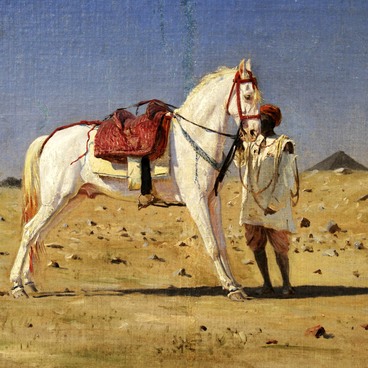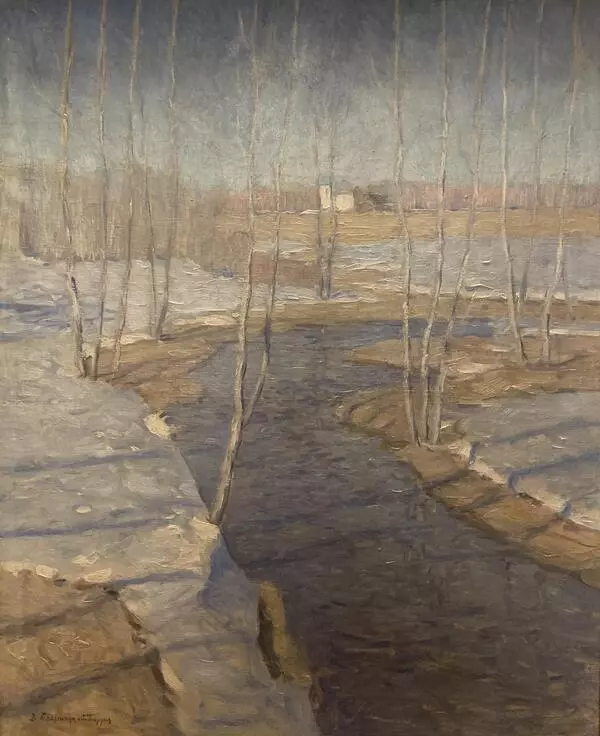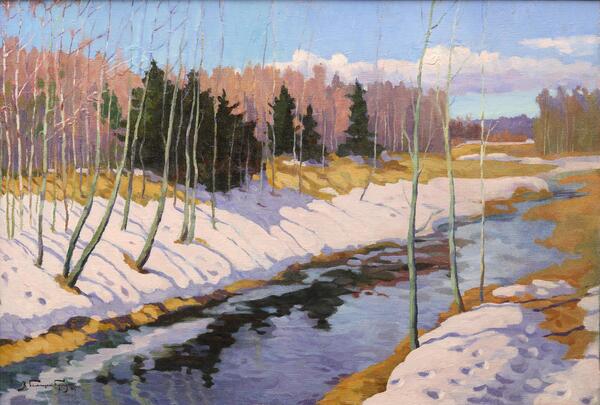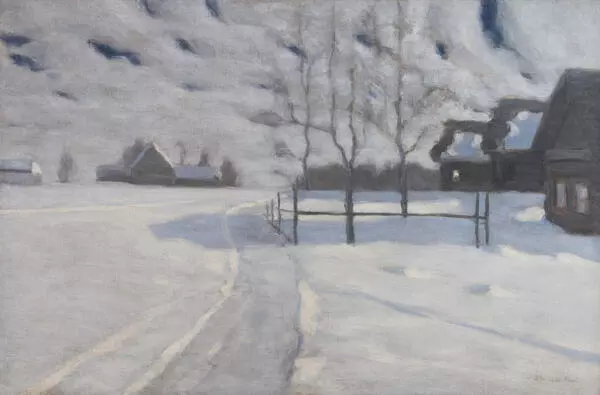Vitold Byalynitsky-Birulya, a Russian artist, was born in 1872 in the territory of contemporary Belorussia. His got his first education in arts in Kiev to join Moscow School of painting, sculpture and architecture later. In Moscow, he met Isaac Levitan, a great Russian landscapist, and, driven by his influence, made his mind to dedicate himself to the landscape genre. As soon afterwards as in 1908, his virtuous lyrical landscapes won him the title of an Academic in painting.
In this landscape, ‘The Blue Chapel’ of 1912, Byalynitsky-Birulya paints a lyrical rural scene. The soft color palette of the paining is dominated by hues of blue and gray. The forefront of the painting is a snow-clad village street, on the left and right there are gray log cabins. The obvious centerpiece of the composition is the blue chapel. Its side planks painted blue set off the dullish logs of the peasant homes. It is still unknown whether this painting had a real prototype.
Byalynitsky-Birulya consistently developed the genre of Russian realistic art of the late 19th century. In the USSR, landscape-painting as a genre was frequently criticized as overly scenic and lacking ideas. It was then that the painter created his own sub-genre, the ‘memorial landscape’, paintings showing the places that are linked to the lives of outstanding personalities.
Byalynitsky-Birulya weaved his name in the history of art as a fine and poetic landscapist. His paintings are dominated by the light silvery smoke-colored palette. The painter is noted for his subtle treatment of half-tones and elegance of his coloristic solutions. He often painted inconspicuous and unsophisticated locations to avoid exuberance and shine, yet, the utmost clarity of details makes adds ultimate eloquence to his concise landscapes.
Throughout his long life (the painter died at the age of 85), Byalynitsky-Birulya was a member of many important artistic associations, from the Association of Itinerants to the Association of Artists of Revolutionary Russia. For his outstanding achievements in art, he was awarded the title of the People’s Artist of the Russian Soviet Federated Socialistic Republic. The painter’s canvases have landed with the collections of the State Russian Museum and the Tretyakov Gallery, as well as several major museums in Ukraine and Belorussia.
In this landscape, ‘The Blue Chapel’ of 1912, Byalynitsky-Birulya paints a lyrical rural scene. The soft color palette of the paining is dominated by hues of blue and gray. The forefront of the painting is a snow-clad village street, on the left and right there are gray log cabins. The obvious centerpiece of the composition is the blue chapel. Its side planks painted blue set off the dullish logs of the peasant homes. It is still unknown whether this painting had a real prototype.
Byalynitsky-Birulya consistently developed the genre of Russian realistic art of the late 19th century. In the USSR, landscape-painting as a genre was frequently criticized as overly scenic and lacking ideas. It was then that the painter created his own sub-genre, the ‘memorial landscape’, paintings showing the places that are linked to the lives of outstanding personalities.
Byalynitsky-Birulya weaved his name in the history of art as a fine and poetic landscapist. His paintings are dominated by the light silvery smoke-colored palette. The painter is noted for his subtle treatment of half-tones and elegance of his coloristic solutions. He often painted inconspicuous and unsophisticated locations to avoid exuberance and shine, yet, the utmost clarity of details makes adds ultimate eloquence to his concise landscapes.
Throughout his long life (the painter died at the age of 85), Byalynitsky-Birulya was a member of many important artistic associations, from the Association of Itinerants to the Association of Artists of Revolutionary Russia. For his outstanding achievements in art, he was awarded the title of the People’s Artist of the Russian Soviet Federated Socialistic Republic. The painter’s canvases have landed with the collections of the State Russian Museum and the Tretyakov Gallery, as well as several major museums in Ukraine and Belorussia.








